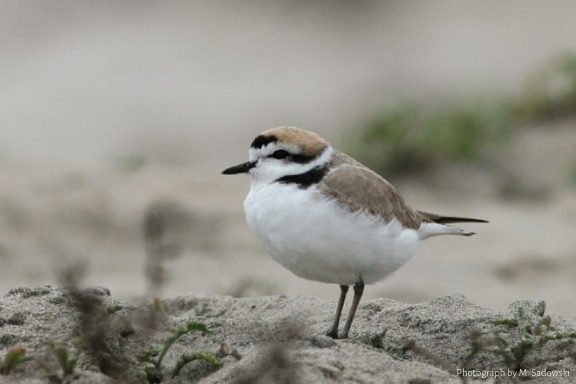
.jpg)
.jpg)
.jpg)
.jpg)
Plover Protection
The Western Snowy Plover is a small, light colored ground-nesting shorebird with black or dark brown markings on the head and breast. Snowy plovers raise their young on unraked beaches in Coronado, Silver Strand and Imperial Beach. Once numbering in the thousands, fewer than 1,500 breeding plovers remain in California. Where it lives on beaches, its nesting attempts are often disrupted by human visitors who fail to notice that they are keeping the bird away from its nest; as a result, the Snowy Plover populations have declined in many coastal regions1. The Pacific Coast population of the Western Snowy Plover is federally listed as threatened and is protected by the Endangered Species Act.
At Silver Strand, snowy plovers nest in the dunes south of parking lot 1. The dunes and adjacent beach comprise the Silver Strand Natural Preserve, a subunit of Silver Strand SB designated specifically to protect the snowy plovers. Plover nesting areas are delineated with twine and fiber glass poles to protect plovers from people, kites and dogs. This fencing is a symbolic barrier that allow plovers to pass freely between the nesting area and wrack line where they feed. The nesting area is closed to the public year-round for the safety and protection of the snowy plover.
State Parks maintains the fencing and signage around the nesting area, and monitors the snowy plover populations year-round. Silver Strand survey data is compiled with data from other State Parks that manage snowy plover populations, to help assess the health of the California coastal population. Check out the current monitoring summary below for plovers at Silver Strand.
You Can Help!
- Do not approach birds or nests.
- Do not feed wildlife.
- Do not bring dogs to Silver Strand SB.
- Dispose of garbage properly to avoid attracting gulls, crows and other plover predators.
- Avoid prolonged lounging near the plover nesting area.
- Stay out of fenced or posted habitat areas.
- Leave kelp and driftwood on the beach.
- Do not light fireworks, fly kites, hang glide, toss frisbees, or toss balls near the plover nesting area.
No Dogs at Silver Strand
Dogs are not allowed on the beach, tunnels and bayside. Visitors may bring dogs to the parking lots, but the dogs may not enter the beach. Snowy plovers are threatened by disturbance, predation and habitat loss. Plovers perceive the presence of any dog, leashed or unleashed, as a danger. Dogs don’t have to catch plovers to harm them. Every time people or dogs cause the birds to take flight or run away, they lose precious energy that is needed to maintain their nests. When a plover parent is disturbed, it will abandon its nest, increasing the chance of a predator finding the eggs, sand blowing over and covering the nest, or the eggs getting cold. This can decrease the number of chicks that hatch. A frightened snowy plover may even crush its own eggs or lose its chicks while running off.
Where can I take my dog?
Dogs off-leash are welcome at Coronado Dog Beach, Vetter Park and Coronado Cays Dog Park. Dogs entering off-leash areas must respond to voice command.
Dogs on-leash are welcome at the Tijuana Estuary trails, Silver Strand parking lots, Bayshore Bikeway, Coronado Tidelands Park and Boardwalk at the Hotel Del Coronado. Owners are responsible for control and clean-up of their dogs.
Plover Biology
The coastal snowy plover population breeds along the Pacific coast, from southern Washington to southern Baja California, Mexico, with the majority of birds breeding along the California coast. Plovers search the wet sand for crustaceans, and also like to eat beach flies found in the piles of kelp and seaweed washed up on the beach, known as wrack. Snowy plovers and their eggs are well-camouflaged and extremely hard to see. Look for plovers crouching in small depressions taking shelter from the wind or scurrying down to the water's edge for food.
During winter, snowy plovers eat and rest in order to build up their fat reserves. In the spring and summer, plovers nest in loose colonies, often coming back to the same beaches every year. Nesting season lasts from early spring to mid-fall, and during that time the female may hatch more than one brood with different males. The nests are simple scrapes in the sand with 1-3 eggs that the male warms at night, while the female does day duty. Eggs hatch in about 27 days, and within hours the chicks are searching for their food of insects and other beach invertebrates. The chicks are on their own in 30 days.
1 Kaufman, Kenn. Lives of North American Birds. , 1996. Print.
